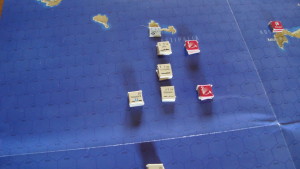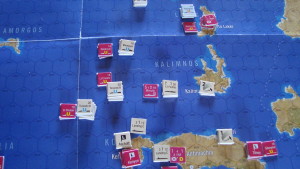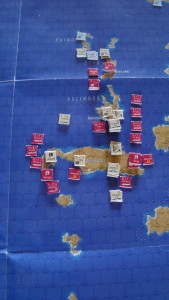My great friend Tim drove out from Portland on Friday for a short weekend of wargaming. We hadn’t played Europa in ages so it had been agreed some weeks before to try a Battle of the Bulge scenario published in Europa Magazine. More on that game in a separate post.
I met Tim back in 1998, just after moving to Portland. Our meeting was prompted by my post in the old Lysator Europa discussion group about FTF opponents in Portland.
After two “get acquainted” meetings in brewpubs, we started playing Europa on a weekly basis. Lots of games, lots of scenarios. By our count we’ve played War In The Desert at least 4 times, (by my reckoning the horrific) For Whom The Bell Tolls a couple of times, who knows how many tries at Second Front, including an epic 1943 Sledgehammer scenario (those P-40s just don’t get the job done….give me a P-47 every time) that made Dieppe look like a smashing success. I can’t even guess at how many times we played Narvik, Balkan Front, and Winter War.
We even played Second Front at GameStorm twice. The first time Tim invited a couple of players from his Newberg Saturday wargaming group to participate. These gentlemen apparently expected some sort of preparation, order and discipline when it came to the setup. According to Tim, they never recovered from the shock of watching me nonchalantly dumping a mass of counters out of the box onto our assigned table. I figured with four sets of hands and eyes, setup would be a snap. Suffice to say it was not the most congenial of games after that. I melted down on Sunday of our second appearance after our studious next door neighbors were replaced by a group of children playing some type of miniature skittle bowling game, complete with screaming. Words were exchanged.
By 2010, Tim and I started playing GMT published card driven games. Our favorites are Paths of Glory, Pursuit of Glory, Wilderness War and Thirty Years War. This trend continued when I moved because it is damn near impossible to finish a Europa game in a couple of days.
One reason for this is that we don’t necessarily focus on the game all the time. Lots of talking about current events, past games, horrendous die rolls, beer drinking, DVDs and (in season) football watching.
But no mistake about this, Tim is an extremely skilled and focused player. Much more so than I am. He’s a Europa Experten who has gradually (and there have been years over which to do this) come to terms with the demise of that franchise, and HMS/GRD’s inability to deliver their remake of Scorched Earth; Total War. Tim is happiest when playing games with very high counter density, so this game has been his Holy Grail. Not even March To Victory has satisfied his need for towering stacks of counters.
I’m looking forward to our next meeting.


